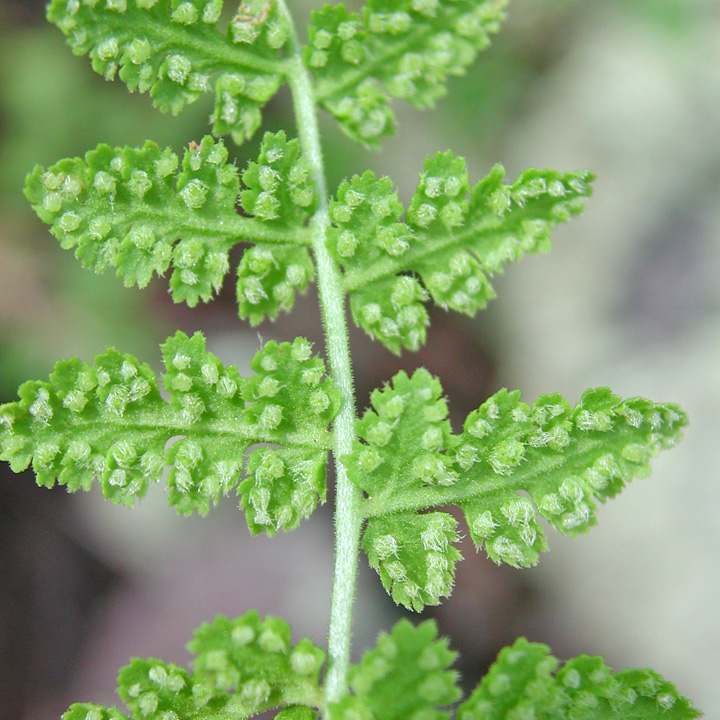Woodsia
|
Family: Woodsiaceae |
Plants usually on rock. Stems compact to creeping; ascending or erect (rarely horizontal), stolons absent. Leaves monomorphic, dying back over winter or sometimes persistent into the next season. Petiole 1/5--3/4 length of blade, base not conspicuously swollen; vascular bundles 2, arranged laterally, ± round or oblong in cross section. Blade linear to lanceolate or ovate, 1--2-pinnate-pinnatifid, gradually reduced distally to pinnatifid apex, herbaceous. Pinnae not articulate to rachis, segment margins entire to dentate, not spiny; proximal pinnae somewhat reduced, sessile, bases usually ± equilateral; costae often shallowly grooved adaxially, grooves ± continuous from rachis to costae; indument of glandular (occasionally nonglandular) hairs on both surfaces, rarely absent. Veins free, simple or forked. Sori in 1 row between midrib and margin on ultimate segments, round; indusia basal, dissected into several to numerous filamentous or scalelike segments encircling sorus, persistent but often obscure in mature sori. Spores brownish, cristate, rarely rugose. x = 38, 39, 41. Woodsia is a well-marked genus; its morphology and chromosome base number ( x = 41) provide evidence of relationships to the dryopteroid ferns. Most authors consider Cystopteris to be its closest ally, and the two genera are often confused in herbarium collections. The resemblance is superficial in many ways, however, and Woodsia is easily distinguished from Cystopteris by its persistent petiole bases, multilobed indusia, and obscure veins that end in hydathodes before reaching the leaf margin. The North American species of Woodsia fall into two natural groups that might be recognized as subgenera. Woodsia ilvensis , W . glabella , and W . alpina have articulate petioles, indusial segments that are uniseriate throughout and composed of cells that are much longer than wide, entire or crenate pinnules, strictly concolored stem scales, and chromosome base numbers of 39--41. They are circumboreal in distribution and show clear affinities to species found only in Eurasia. The remainder of the North American taxa have petioles that are not articulate, indusial segments that are multiseriate at the base and composed of cells that are isodiametric or slightly longer than wide, dentate pinnules, often bicolored stem scales, and a chromosome base number of 38. All of these species are endemic to the New World and probably represent a distinct lineage within the genus. Hybridization is common within these natural groups, but intergroup hybrids are relatively rare.
Petiole slender and wiry, shorter than the blade, scaly at least at the base, with 2 bundles, these uniting distally; blade pinnate to subtripinnate, scaly or scaleless, often hairy or glandular, the veins forking and free, not reaching the margin; sori borne on the veins, often confluent in age, rotund but with an elongate receptacle; indusium inferior, borne below and ±surrounding the sporangia, consisting variously of septate hairs around a minute basal disk, or of a small sac that soon ruptures irregularly to form a small basal disk with spreading, unequal segments; small to medium-sized ferns of rocky places, with tufted lvs and persistent, elongate petiole-bases on a short rhizome that is covered with yellowish to dark brown scales. 20-25, cosmop. Gleason, Henry A. & Cronquist, Arthur J. 1991. Manual of vascular plants of northeastern United States and adjacent Canada. lxxv + 910 pp. ©The New York Botanical Garden. All rights reserved. Used by permission. |

